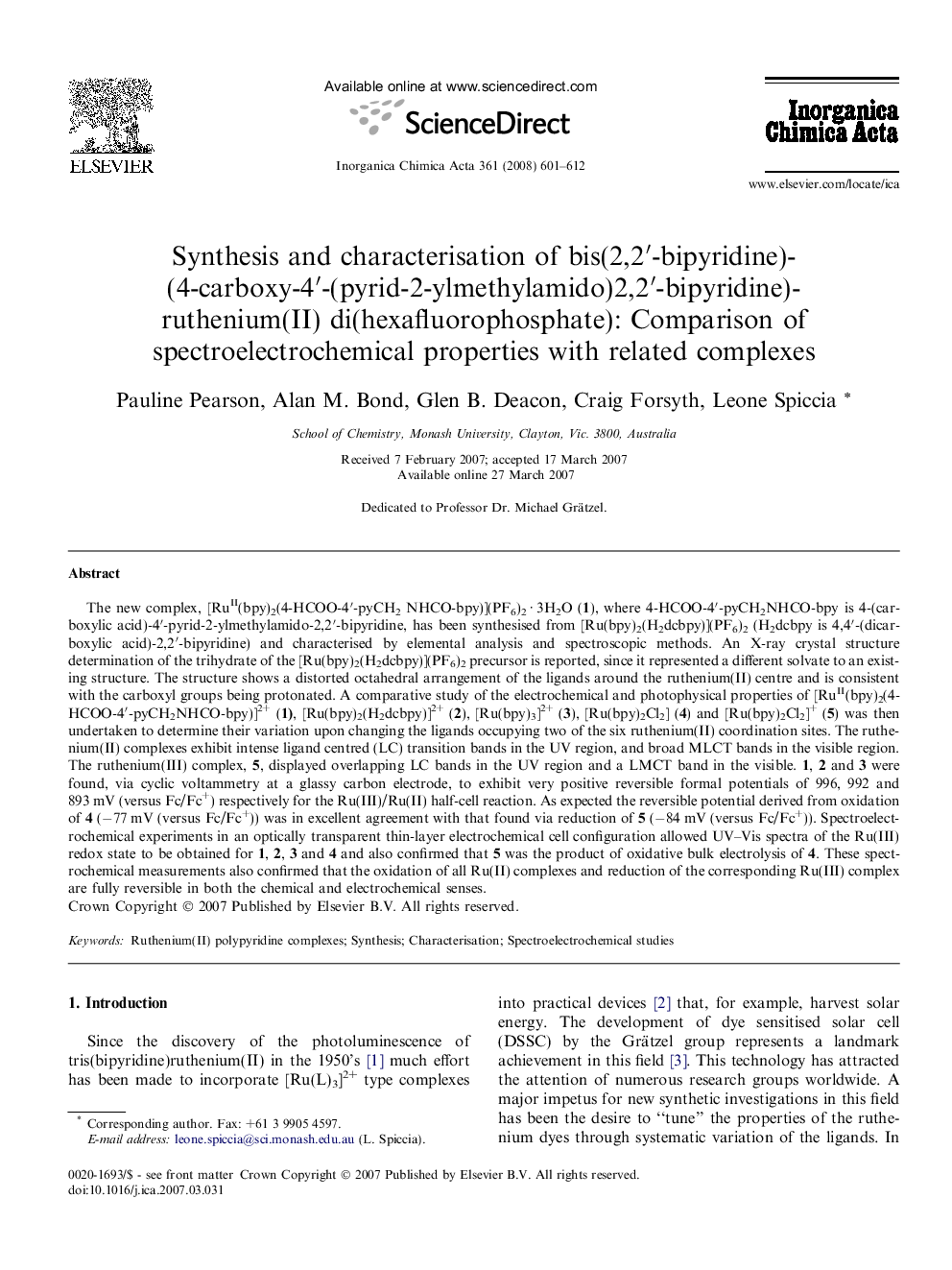| کد مقاله | کد نشریه | سال انتشار | مقاله انگلیسی | نسخه تمام متن |
|---|---|---|---|---|
| 1309228 | 975199 | 2008 | 12 صفحه PDF | دانلود رایگان |

The new complex, [RuII(bpy)2(4-HCOO-4′-pyCH2 NHCO-bpy)](PF6)2 · 3H2O (1), where 4-HCOO-4′-pyCH2NHCO-bpy is 4-(carboxylic acid)-4′-pyrid-2-ylmethylamido-2,2′-bipyridine, has been synthesised from [Ru(bpy)2(H2dcbpy)](PF6)2 (H2dcbpy is 4,4′-(dicarboxylic acid)-2,2′-bipyridine) and characterised by elemental analysis and spectroscopic methods. An X-ray crystal structure determination of the trihydrate of the [Ru(bpy)2(H2dcbpy)](PF6)2 precursor is reported, since it represented a different solvate to an existing structure. The structure shows a distorted octahedral arrangement of the ligands around the ruthenium(II) centre and is consistent with the carboxyl groups being protonated. A comparative study of the electrochemical and photophysical properties of [RuII(bpy)2(4-HCOO-4′-pyCH2NHCO-bpy)]2+ (1), [Ru(bpy)2(H2dcbpy)]2+ (2), [Ru(bpy)3]2+ (3), [Ru(bpy)2Cl2] (4) and [Ru(bpy)2Cl2]+ (5) was then undertaken to determine their variation upon changing the ligands occupying two of the six ruthenium(II) coordination sites. The ruthenium(II) complexes exhibit intense ligand centred (LC) transition bands in the UV region, and broad MLCT bands in the visible region. The ruthenium(III) complex, 5, displayed overlapping LC bands in the UV region and a LMCT band in the visible. 1, 2 and 3 were found, via cyclic voltammetry at a glassy carbon electrode, to exhibit very positive reversible formal potentials of 996, 992 and 893 mV (versus Fc/Fc+) respectively for the Ru(III)/Ru(II) half-cell reaction. As expected the reversible potential derived from oxidation of 4 (−77 mV (versus Fc/Fc+)) was in excellent agreement with that found via reduction of 5 (−84 mV (versus Fc/Fc+)). Spectroelectrochemical experiments in an optically transparent thin-layer electrochemical cell configuration allowed UV–Vis spectra of the Ru(III) redox state to be obtained for 1, 2, 3 and 4 and also confirmed that 5 was the product of oxidative bulk electrolysis of 4. These spectrochemical measurements also confirmed that the oxidation of all Ru(II) complexes and reduction of the corresponding Ru(III) complex are fully reversible in both the chemical and electrochemical senses.
We report the novel complex [RuII(bpy)2(4-COOH-4′-pyCH2NHCO-bpy)]2+ (1) and a comparisons of its electrochemical and photophysical properties related to tris(bipyridyl) ruthenium(II) complexes; the complex is an ideal candidate for use in biomedical applications, involving electrochemical or photochemical detection, as the carboxylic acid group allows for attachment to various substrates and biomolecules.Figure optionsDownload as PowerPoint slide
Journal: Inorganica Chimica Acta - Volume 361, Issue 3, 15 February 2008, Pages 601–612